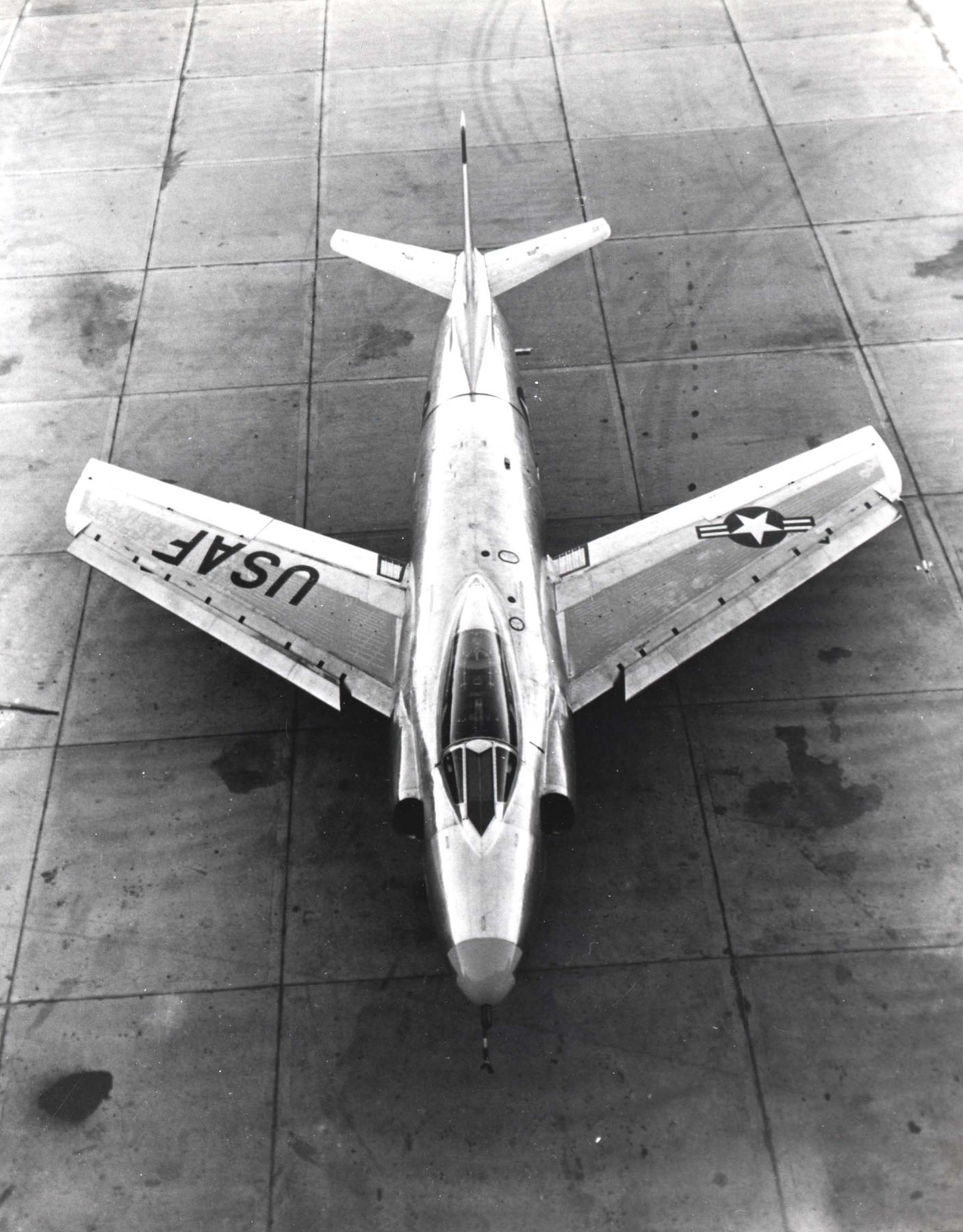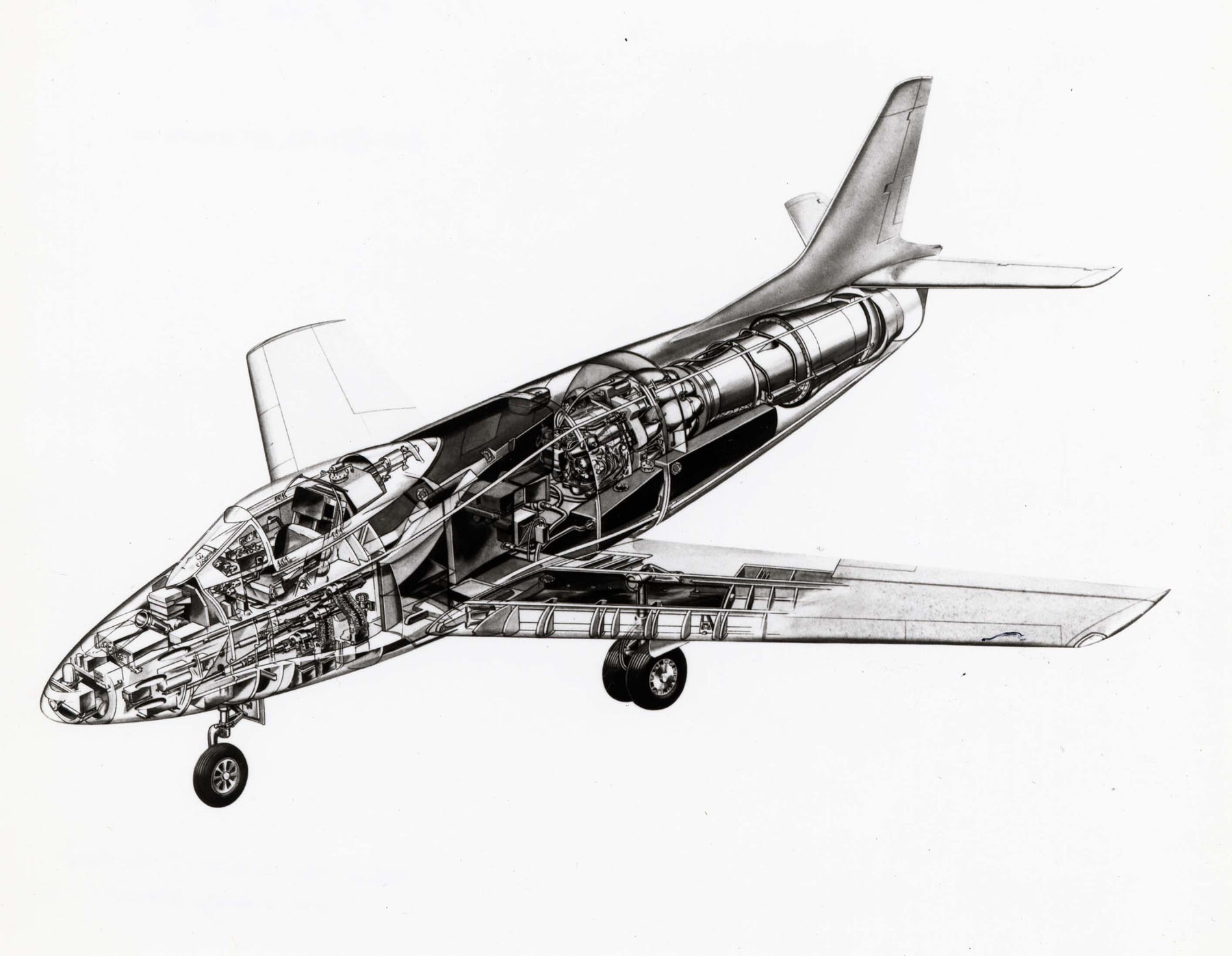North American YF-93 on:
[Wikipedia]
[Google]
[Amazon]
 The North American YF-93 was an American fighter development of the
The North American YF-93 was an American fighter development of the
 The prototypes, serial numbers 48-317 and -318, began flight tests in 1950 and were entered in a flyoff against the other penetration fighter projects, the XF-88 and XF-90; the XF-88 Voodoo was declared the winner. None of the projects would be ordered. The YF-93As were turned over to the
The prototypes, serial numbers 48-317 and -318, began flight tests in 1950 and were entered in a flyoff against the other penetration fighter projects, the XF-88 and XF-90; the XF-88 Voodoo was declared the winner. None of the projects would be ordered. The YF-93As were turned over to the



National Museum of the USAF: North American YF-93A Fact Sheet
– ''Flight'' Archive, 18 May 1950 {{USAF fighters F-93 1950s United States fighter aircraft Single-engined jet aircraft Low-wing aircraft Cancelled military aircraft projects of the United States YF-93 Aircraft first flown in 1950
 The North American YF-93 was an American fighter development of the
The North American YF-93 was an American fighter development of the F-86 Sabre
The North American F-86 Sabre, sometimes called the Sabrejet, is a transonic jet fighter aircraft. Produced by North American Aviation, the Sabre is best known as the United States' first swept-wing fighter that could counter the swept-wing Sov ...
that emerged as a radically different variant that received its own designation. Two were built and flown before the project was eventually canceled.
Design and development
In 1947, North American Aviation began a design study, NA-157, to create a true " penetration fighter" to meet the requirements of a long-range version of its F-86A Sabre. In order to accommodate more fuel, a much larger F-86A was envisioned, eventually able to carry , both internally and with two underwing drop tanks. The new variant possessed a theoretical unrefuelled range of over , twice that of the standard production F-86A. The resultant fighter originally designated the F-86C was intended to compete with the XF-88 Voodoo andLockheed XF-90
The Lockheed XF-90 was built in response to a United States Air Force requirement for a long-range penetration fighter and bomber escort. The same requirement produced the McDonnell XF-88 Voodoo. Lockheed received a contract for two prototype ...
to fulfill the USAF's Penetration Fighter requirement for a bomber escort.
The F-86C was much larger and heavier, weighing in at more than its antecedent. The increased weight and girth necessitated a dual-wheel main landing gear, increased wing area and a more powerful engine, the Pratt & Whitney J48
The Pratt & Whitney J48 (company designation JT7 Turbo-Wasp) is a turbojet engine developed by Pratt & Whitney as a license-built version of the Rolls-Royce Tay. The Tay/J48 was an enlarged development of the Rolls-Royce Nene (Pratt & Whitney ...
rated at static thrust and thrust available in afterburner. With the SCR-720 search radar and six 20 mm (.79 in) cannon mounted in the nose where the air intake was on the F-86A, the engineers designed a novel set of flush-mounted NACA inlets.
In December 1947, the Air Force ordered two prototype NA-157s and, considering the many changes to the F-86, redesignated it YF-93A. Both prototypes were built with NACA inlet ducts; the first, (48-317), was later retro-fitted with more conventional intakes. Six months later, the initial contract was followed up with an order for 118 F-93A-NAs. In 1949, the production order was abruptly canceled as priorities had shifted dramatically following the testing of the ground-breaking Boeing B-47
The Boeing B-47 Stratojet (Boeing company designation Model 450) is a retired American long- range, six-engined, turbojet-powered strategic bomber designed to fly at high subsonic speed and at high altitude to avoid enemy interceptor aircraft ...
which reputedly would not need an escort due to its high speed capabilities. With the prototype YF-93As just coming off the production line, the USAF took over the project.
Operational history
 The prototypes, serial numbers 48-317 and -318, began flight tests in 1950 and were entered in a flyoff against the other penetration fighter projects, the XF-88 and XF-90; the XF-88 Voodoo was declared the winner. None of the projects would be ordered. The YF-93As were turned over to the
The prototypes, serial numbers 48-317 and -318, began flight tests in 1950 and were entered in a flyoff against the other penetration fighter projects, the XF-88 and XF-90; the XF-88 Voodoo was declared the winner. None of the projects would be ordered. The YF-93As were turned over to the National Advisory Committee for Aeronautics
The National Advisory Committee for Aeronautics (NACA) was a United States federal agency founded on March 3, 1915, to undertake, promote, and institutionalize aeronautical research. On October 1, 1958, the agency was dissolved and its assets ...
(NACA) AMES facility for further testing before being utilized as chase aircraft until 1956. Flight with the NACA ducts proved troublesome at high angles of attack, restricting air flow to the engines. NACA Research Memorandum A7I06 'An experimental investigation of NACA submerged air inlets in a 1/5-scale model of a fighter airplane', Donald E Gault, Dec 1947 (from Cranfield repository) By this time, however, higher performance aircraft were available and both aircraft were eventually declared surplus and scrapped.
Operators
; *United States Air Force
The United States Air Force (USAF) is the Aerial warfare, air military branch, service branch of the United States Armed Forces, and is one of the eight uniformed services of the United States. Originally created on 1 August 1907, as a part ...
Variants
;F-86C :Original designation for a re-engined variant of the F-86A, two built. ;YF-93A :Two prototype F-86Cs redesignated, ;F-93A :Production variant, order for 118 cancelled.Specifications (YF-93A)



See also
References
Notes
Bibliography
* Angelucci, Enzo and Peter Bowers. ''The American Fighter''. Sparkford, UK: Haynes Publishing Group, 1987. . * Davis, Larry. ''F-86 Sabre in action''. Carrollton, Texas: Squadron/Signal Publications, 1992. . * Pace, Steve. ''X-Fighters: USAF Experimental and Prototype Fighters, XP-59 to YF-23''. Osceola, Wisconsin: Motorbooks International, 1991. . * Sgarlato, Nico and Franco Ragni. ''U.S. Fighters of the Fifties''. Carrollton, Texas: Squadron/Signal Publications, 1979. . * Wagner, Ray. ''The North American Sabre''. London: Macdonald, 1963. No ISBN.External links
National Museum of the USAF: North American YF-93A Fact Sheet
– ''Flight'' Archive, 18 May 1950 {{USAF fighters F-93 1950s United States fighter aircraft Single-engined jet aircraft Low-wing aircraft Cancelled military aircraft projects of the United States YF-93 Aircraft first flown in 1950